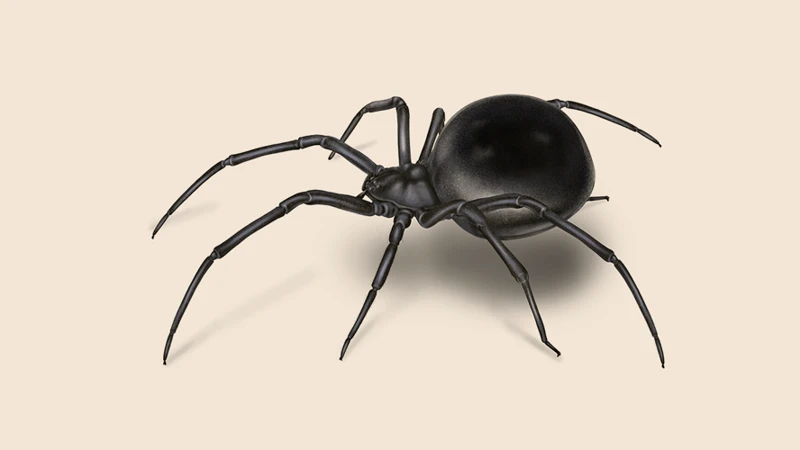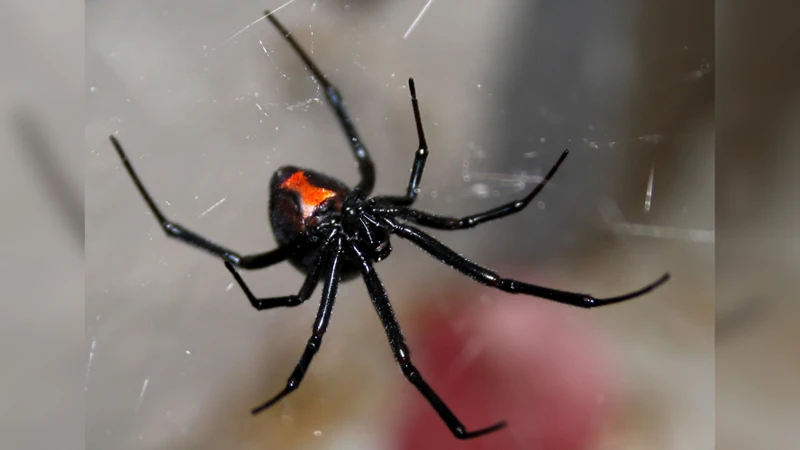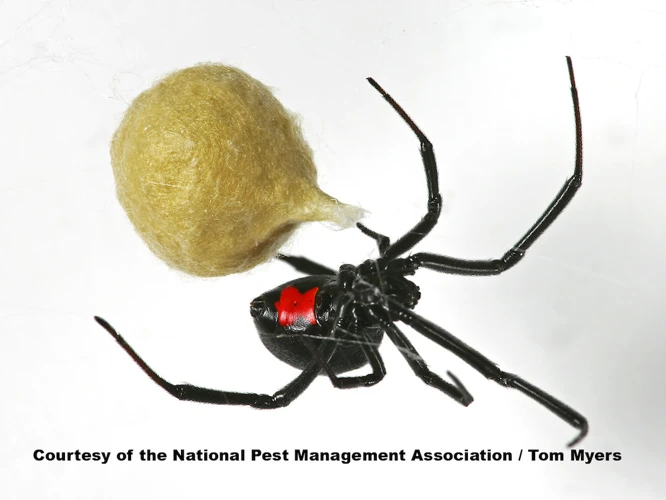As the world of arachnids is filled with a plethora of different species, the black widow spider has earned a notorious reputation due to its venomous bite. These spiders are known to hide in microhabitats that cater to their specific needs, making it difficult for humans to identify their hiding spots. In this guide, we will explore the different microhabitats that black widow spiders prefer and how we can control their presence to avoid any potentially dangerous encounters. Join us in unraveling the mystery of the black widow spider’s preferred microhabitats.
Identifying Microhabitats

Identifying Microhabitats: Where Do Black Widow Spiders Prefer to Live?
Black widow spiders are known for their reclusive behavior and preference for hidden microhabitats, typically close to ground level. Understanding the preferred microhabitat of black widow spiders is crucial in preventing their infestation in your surroundings and avoiding dangerous encounters. In this section, we will explore the types of microhabitats preferred by black widow spiders and the methods to identify and locate them in your environment. We will also discuss the environmental factors that influence their habitat preference. To learn more about black widow spider habitats, check out this article.
Webs and Nests
Microhabitats preferred by black widow spiders include webs and nests that serve as shelter and breeding ground. These spiders are known to spin their webs in various places, such as in crevices, cracks, and corners. They build their webs with sticky silk that traps their prey, providing them with an easy source of food. Black widow spiders are also known for their unique nesting habits, which involve constructing irregular and tangled webs.
The construction of these webs and nests is influenced by specific environmental conditions, such as structural complexity, humidity, and moisture. Research shows that black widow spiders prefer microhabitats that are structurally diverse and complex. They may use objects such as rocks, logs, and plants to construct their webs across, creating multiple layers of complexity that serve to ensnare their prey.
Moisture is also a key factor influencing the construction of black widow spider webs and nests. These spiders prefer microhabitats that have optimum moisture levels and are not too dry or too damp. Moisture helps to maintain the strength and elasticity of their webs, making it easier for them to catch their prey. You can learn more about the importance of moisture in black widow spider habitats by following this link.
The presence of vegetation is also an important factor determining the construction of black widow spider webs and nests. Research shows that controlling vegetation in and around your home can reduce the likelihood of a black widow spider infestation. This is because the spiders prefer microhabitats that have a high degree of structural complexity, which can be provided by an overgrowth of vegetation. You can learn more about controlling vegetation in black widow spider habitats by following this link.
Black widow spiders also prefer microhabitats with a high degree of humidity. High humidity levels can contribute to dew and condensation buildup, which helps to maintain the strength of their webs. You can learn more about the importance of humidity in black widow spider habitats by following this link.
Understanding these factors that influence the preferred microhabitats of black widow spiders can help in identifying and controlling infestations in and around your home. You can learn more about preventing and controlling black widow spider infestations by following this link.
Environmental Conditions
Black widow spiders prefer microhabitats with specific environmental conditions. They are known for their ability to adapt to various environments, but there are certain factors that make a microhabitat more suitable for them. These factors include temperature, humidity, light, and structural complexity.
| Environmental Condition | Description |
|---|---|
| Temperature | Black widow spiders prefer microhabitats with warm temperatures. They can survive in temperatures ranging from cold to hot, but they are most active and produce the most webs in temperatures between 70-90°F. |
| Humidity | Black widow spiders thrive in areas with high humidity, around 40-70%. They are commonly found in areas with moist environments, such as near water sources, and will retreat to dry areas during periods of low humidity. |
| Light | These spiders prefer microhabitats with low light and they are most active during the night. They will create their webs in darker areas to avoid predators and to catch prey more easily. |
| Structural Complexity | Black widow spiders prefer microhabitats with complex structures, which provide cover and protection from predators. They will create their webs in areas with hidden crevices, under rocks, and within vegetation. |
It is important to note that these environmental factors are not the only aspects to consider when identifying a black widow spider’s microhabitat. Other factors, such as prey availability and interactions with other species, can also play a role in their habitat selection. Understanding the unique combinations of these factors can provide insight into the suitability and threat of specific habitats for black widow spiders.
Common Microhabitats

As we delve deeper into the world of black widow spiders, it’s important to identify their most common microhabitats. These elusive creatures prefer specific environments that allow them to thrive and reproduce. By recognizing these microhabitats, we can take appropriate measures to prevent and control their presence. Let’s explore the outdoor and indoor environments where black widows are most likely to be found.
Outdoor Microhabitats
Black widow spiders can be found in various outdoor microhabitats. Here are some potential areas to look out for:
1. Woodpiles – piles of firewood, lumber, or any other wooden debris can be a perfect home for black widow spiders. These piles offer a humid and sheltered environment, which is crucial for the spider’s survival. It is recommended to keep woodpiles away from the house and stored off the ground to prevent black widow spiders from colonizing.
2. Gardens – black widow spiders tend to seek shelter in tall grass, bushes, and dense vegetation. They are commonly found in gardens and other landscaped areas. Gardeners should take caution when working around these areas and wear protective gear to avoid any unexpected bites.
3. Hollowness and cavities – black widows also like to hide in hollow tree stumps, tree hollows, and abandoned animal burrows. They use silk to create a web and form a nest in these locations.
4. Trash and debris – black widows can also be found in piles of rubbish, recycling bins, and other areas where debris accumulates. They conceivably reside there to seek shelter from predators and other extreme environmental conditions.
It’s imperative to note that the above-listed Outdoor Microhabitats are not the only areas to look out for, as they can be found in various other outdoor locations. It is recommended to maintain a tidy and well-kept yard, avoid keeping unnecessary debris outside and remain vigilant. Black widow spiders play crucial roles in the ecosystem, their interactions with their surroundings are tightly linked. You can find more information about black widow habitats and their interactions with the environment by clicking on this link and reading more about black widow habitat suitability by checking this link or learn more about which habitats pose a threat by clicking on this link.
Indoor Microhabitats
Indoor microhabitats are also preferred by black widow spiders as they provide shelter and access to prey. These types of microhabitats are often found in homes, specifically in damp, cluttered, or dark areas. Here are some examples of indoor microhabitats where black widow spiders can be found:
| Indoor Microhabitats | Description |
|---|---|
| Corners and Cracks | Black widow spiders will often create webs in the corners of rooms or in cracks in walls or floors. These areas provide shelter and protection from predators. |
| Basements and Crawl Spaces | Black widow spiders are known to inhabit basements and crawl spaces, especially if they are cluttered or damp. These areas also provide access to other prey such as insects and small rodents. |
| Attics and Garages | Attics and garages are also common indoor microhabitats for black widow spiders. These areas are often dark and cluttered, providing plenty of places for the spiders to hide. |
| Storage Areas | Black widow spiders can also be found in storage areas, such as closets, sheds, and cabinets. These areas are often undisturbed and provide plenty of places to create webs and catch prey. |
It is important to regularly clean and declutter indoor areas to prevent black widow spiders from making these locations their microhabitats. Additionally, sealing cracks and gaps in walls and floors will prevent them from entering homes in the first place. If there is already an infestation, it is important to take proper measures for prevention and control.
Prevention and Control
When it comes to Black Widow spiders, prevention and control are essential for maintaining a safe environment. While they play an important role in our ecosystem, their bites can be harmful to humans and pets. It’s important to take measures to prevent infestations and control their presence if necessary. In this section, we will take a closer look at the different prevention and control methods available, both natural and chemical. By understanding these options, you can keep your home and yard free of Black Widow spiders and their potential dangers.
Natural Prevention Methods
When it comes to controlling and preventing black widow spiders from setting up their microhabitats in your home or yard, various natural methods have proven effective. These methods generally don’t involve the use of harsh chemicals or poisons, making them a safer and more eco-friendly choice.
Removing Clutter and Debris: One effective way to prevent black widow spiders from creating their microhabitats is to minimize clutter and debris in and around your home. This means keeping your yard free of piles of brush, wood, and rocks, and storing firewood and other items off the ground.
Sealing Entry Points: Black widow spiders tend to enter homes and buildings through small cracks and crevices. Sealing up these entry points can prevent the spiders from infiltrating your living space.
Natural Repellents: Certain natural substances, such as peppermint oil, eucalyptus oil, and vinegar, have been shown to repel spiders. These substances can be sprayed around windows, doors, and other areas where spiders may try to enter.
Keeping Your Home Clean: Black widow spiders thrive in messy and dirty environments. Keeping your home clean and free of dust and debris can help prevent these spiders from setting up camp.
To summarize, there are many natural methods that you can use to prevent black widow spiders from creating their microhabitats in and around your home. By removing clutter and debris, sealing entry points, using natural repellents, and keeping your home clean, you can effectively control the spider population without resorting to harsh chemicals or poisons.
Chemical Control Methods
Chemical control methods involve the use of insecticides to kill black widow spiders. While these methods are effective, they should be used with caution as they can be harmful to both humans and the environment. Here are some chemical control methods that you can use to eliminate black widow spiders:
- Insecticidal sprays: Insecticidal sprays are one of the most popular chemical control methods used to kill black widow spiders. These sprays are easy to use and can be sprayed directly onto the spiders and their webs. They contain chemicals that are toxic to black widow spiders and other insects. However, be sure to read the label carefully before use to ensure that it is safe for use indoors or outdoors.
- Dusts: Insecticidal dusts are another chemical control method that can be used to eliminate black widow spiders. These dusts contain chemicals that the spiders will pick up as they walk over them. The chemicals will then be ingested by the spider, leading to its death. Insecticidal dusts can be used in cracks and crevices where black widow spiders may be hiding.
- Baits: Insecticidal baits can also be used to eliminate black widow spiders. Baits contain chemicals that are attractive to the spiders and are usually placed in areas where the spiders are known to nest or crawl.
- Foggers: Insecticidal foggers are another chemical control method that can be used to eliminate black widow spiders. Foggers release a cloud of insecticide into the air, killing spiders upon contact. However, foggers should be used with caution as they can be harmful to humans and pets if not used properly.
It is important to note that before using any chemical control method, you should always read the label carefully and follow the instructions to ensure that it is used safely and effectively. If you are unsure of how to use a particular product, consider hiring a professional pest control company to do the job for you.
Conclusion
After learning about the microhabitats preferred by black widow spiders and how to identify them, it’s important to take preventative measures to ensure they don’t invade our living spaces. While black widow spiders are venomous and dangerous, it’s not necessary to panic. By taking some simple precautions, we can keep our homes and outdoor areas free from these arachnids.
Natural prevention methods: One of the best ways to prevent black widow spiders from taking up residence in your yard or home is to eliminate shelter and breeding sites. Regularly remove debris, clutter, and outdoor furniture where spiders may hide. Keep indoor areas well-lit, clean, and organized. Sticky traps can also be used to capture spiders inside the home.
Chemical control methods: If the natural prevention methods do not work, chemical control may be necessary. Insecticides containing pyrethroids can be used, but it’s important to read and follow the label instructions carefully. It’s also best to hire a professional pest control service to apply the insecticides safely and effectively.
In conclusion, it’s important to know what microhabitats black widow spiders prefer and how to identify them. By taking preventative measures and using natural and chemical control methods, we can keep our living spaces safe from these venomous spiders. Remember to always take care when dealing with spiders, and if you are bitten by a black widow spider, seek medical attention immediately.
Frequently Asked Questions
How can I identify a black widow spider?
Black widows are typically black with a characteristic red hourglass shape on their underside. However, this marking may not always be present. Females are usually larger than males and have a rounder abdomen.
What kind of webs do black widows make?
Black widows construct irregular, tangled webs usually found close to the ground. The webs are often located in dark and hidden areas such as under rocks, in vegetation, or in wood piles.
Why do black widows prefer outdoor microhabitats?
Black widows are attracted to outdoor microhabitats due to the abundance of insects that serve as a food source. They also prefer an environment with moderate temperatures and high humidity.
What is the benefit of identifying black widow microhabitats?
Identifying black widow microhabitats can help in preventing and controlling their populations within an area. It is easier to implement control measures when you know where they are located.
How can I prevent black widow infestations in my home?
Sealing cracks and crevices, removing debris or clutter from around the property, and removing spider webs frequently can prevent black widows from entering your home. Keeping clutter out of the house and storing firewood away from the house can also help.
What are some natural prevention methods for controlling black widow populations?
Planting eucalyptus or lavender around your home can repel spiders. Also, keeping a clean house with low humidity levels can help in deterring black widows.
What are some chemical control methods for black widows?
Chemical control methods such as insecticides should be used with caution and only by a professional. Treatment may involve spraying or dusting infested areas and potential hiding spots to kill black widow spiders and their eggs.
Can black widows be deadly to humans?
Yes, black widows have venomous bites that can be dangerous to humans. While not all bites result in serious reactions, some individuals may require medical attention after being bitten.
Do black widows have any predators?
Black widows have a natural predator in the prairie falcon, which feeds on the spiders. Other predators include lizards and some species of birds.
What should I do if I find a black widow spider in my home?
If you find a black widow spider in your home, do not handle it. Vacuum it up with a vacuum cleaner or trap it with a sticky trap. If you suspect that you have been bitten, seek medical attention immediately.







